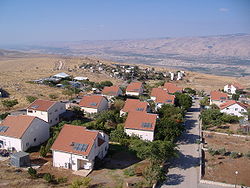Hemdat
 From Wikipedia - Reading time: 6 min
From Wikipedia - Reading time: 6 min
Hemdat
חמדת | |
|---|---|
 | |
| Coordinates: 32°15′07″N 35°31′37″E / 32.25194°N 35.52694°E | |
| District | Judea and Samaria Area |
| Council | Bik'at HaYarden |
| Region | West Bank |
| Affiliation | Amana |
| Founded | 1979 |
| Founded by | Nahal |
| Population (2023)[1] | 386 |
Hemdat (Hebrew: חמדת) is a community Israeli settlement in the West Bank located near the Palestinian hamlet of Khirbet Makhoul,[2][3] in the Jordan River Valley on a plain at an altitude of 178 metres along the Allon Road in the municipal jurisdiction of the Bik'at HaYarden Regional Council. Other Israeli settlements in the area are Ro'i and Beka'ot. The closest city, Beit Shean, is a thirty-minute drive north of Hemdat. In 2023 it had a population of 386.
The international community considers Israeli settlements in the West Bank illegal under international law, but the Israeli government disputes this.[4]
History
[edit]Hemdat was first established in 1979,[5] as a pioneer Nahal military outpost that was soon thereafter demilitarized and turned into a kibbutz when turned over to residential purposes to a group of pioneers from Hashomer Hatzair and Israel Boy and Girl Scouts Federation.[5] Due to the harsh living conditions of the valley (intense heat, distant location) and other obstacles, this group abandoned the kibbutz and the village was returned to the Israel Defense Forces Nahal brigade. In 1997, a new group organized by the Amana settlement organization and moved to resettle Hemdat.[5] This group was made up of students at the Bnei David Mechina pre-military yeshiva academy in Eli and one family named Shitrit.[5]
Education
[edit]Three months after the re-founding of the village, a religious pre-military academy was established called Hemdat Yehuda.[citation needed]
Other educational institutions include a nursery school and a kindergarten. Young children learn at the elementary school on the Sde Eliyahu kibbutz. The older youth learn at the Sde Eliyahu High School, and other institutions in the area and elsewhere.[citation needed]
Demographics
[edit]Hemdat does not have a homogeneous population and it is made up of a mixed group of families from different Jewish ethnic backgrounds and locations in Israel.[citation needed] There is one central synagogue that serves the village, as well as religious services at the academy.[citation needed]
References
[edit]- ^ "Regional Statistics". Israel Central Bureau of Statistics. Retrieved 11 August 2025.
- ^ Gideon Levy and Alex Levac, 'In the Jordan valley, the inhuman-yet-human bulldozers came at dawn,' at Haaretz, September 20, 2013.
- ^ Reuters and Gili Cohen 'European diplomats: Israeli army manhandled us, seized Palestinian aid,' at Haaretz, September 20, 2013.
- ^ "The Geneva Convention". BBC News. 10 December 2009. Retrieved 27 November 2010.
- ^ a b c d Hemdat Archived 2017-01-21 at the Wayback Machine Bik'at HaYarden Regional Council (in Hebrew)
 KSF
KSF
